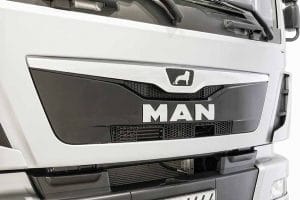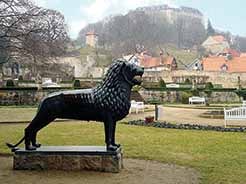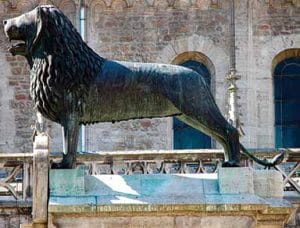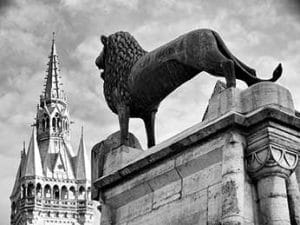The Lion of Brunswick has a special place of honour on MAN trucks.
Story by Milan Olsansky
Animals adorning the emblem of an automobile manufacturer is not new or isolated. They could be linked with what inspired an automotive brand, its history or the history of the origin they belong to. The most common form of animals that have adorned the emblems of automobile brands include a horse, lion and a snake. To a human mind, these are powerful creates; even mythical to an extent. The Pegasus for example, or the giant snake adorning of emblem of Alfa Romeo, which is said to have been inspired from Biscione Visconteo, the coat of arms of the city of Milan and of the Visconti family that ruled it in medieval times.
Like the snake adorning the emblem of Alfa Romeo or the ‘red’ horse adorning the grille of a Ferrari, the grille of M.A.N trucks and buses have a lion as an emblem. It looks mystical to say the least, and coming from the Munich-based CV major it arouses much curiosity. This curiosity is whether the lion in question is the lion associated with knight Brunclik? If it has a cardinal connection with the people of Czech Republic? If it is the same lion that knight Brunclik saved? It is the same lion that came to accompany the brave hero for the rest of his life? The final resting place of this lion came to be the coat of arms of the knight. And, as the legend would have it, this lion came to grow a double tail after the knight accidentally cut him with a sword in two in a bitter fight with a dragon. The reference to this is found in Alois Jirásek’s (important Czech writer, 19th and And 20th. century, 1851 – 1930) writing in the Legends of the Christian Age. There’s a chapter ‘About Bruncvík’.
Proven history
Starting with what is clear and provable, M.A.N was established in 1908. In less than seven years it began to produce trucks (1915), which gradually became its main production stream. As part of various acquisitions of competing manufacturers, M.A.N. in 1969 acquired a share in the car factory Büssing (founded in 1903 by Heinrich Büssing). Büssing was established before WW1 in Braunschweig as a truck building company. It built its diesel engine for trucks in 1930. It built its first truck with a flat diesel engine located between the two axles, and under the superstructure in 1936. In 1934, Büssing took over the company NAG – Neue Automobil Gesellschaft. In 1962, it acquired a company called Borgward. In this company, Büssing produced military four-tonne 4×4 cars before selling it in 1968 to Faun-Werke GmbH.
Pioneering horizontal ‘underfloor’ diesel engines and supplying military vehicles during WW2, Büssing also manufactured buses successfully. Over time, it developed strong ties with M.A.N. In fact, M.A.N was its customer and used to source vehicles as well as parts. In a turn of events, M.A.N, in 1971, announced that it was taking over Büssing. By doing this, M.A.N came to use the lion logo on its newly named ‘MAN-Büssing’ trucks. Apart from an opportunity to grow its production capacity, M.A.N, through Büssing, also got to use the lion logo, referred to as Braunschweiger Löwe (Braunschweiger Löwe). Coming to M.A.N as the original icon of the city of Brunswick (German: Brunesguik, later Braunschweig), the lion emblem came to adorn the grille of all the vehicles manufactured by the company in due course of time.
As for the lion statue, it was cast in 1166 by Henry the Lion of Brunswick, Duke of Bavaria and Saxony (1129 – 1195), as a symbol of his power, authority and jurisdiction. It was placed on the Burgplatz (castle square) in front of Dankwarderode Castle and Brunswick Cathedral. Thanks to the monumental statue of the king of animals, the castle is also known as Burglöwe (Lion’s Castle). Considered as the oldest and largest preserved medieval statue north of the Alps, the Brunswick lion is also the first figural composition of the end of antiquity. Information about who cast the statue is not to be found, but a masterpiece it really is. There is room to believe that it was a master directly from Brunswick. Weighing about 880 kg, the statue is 1780 mm high and 2790 mm long. The maximum wall thickness is 12 mm. As part of the preservation of the original sculpture, what stands today is a successful copy at Burgplatz in Braunschweig. Various replicas of the Brunswick lion statue can be found both in Germany (for example Goslar, Lübeck, Schwerin) and abroad. Victoria and Albert Museum London for example. And, the Harvard University, USA, for example too.
Legends and myths
Diving into orders, stories and legends, Henry, the Duke of Bavaria and Saxony, came across a lion fighting a dragon on his way to Jerusalem. He joined the lion in his fight. The lion then accompanied his savior for the rest of his life. This legend was popular in Germany, Holland, Denmark and Sweden. There were modified versions of the same story too in the Czech Republic, Hungary and Russia. But these are not the original, and come from the French legend of the knight Yvain. According to the Czech legend, the knight Bruncvík (also called Brunclík) was the son of the Czech prince Žibrid (according to another version of prince Štylfryd), who conquered the eagle emblem for the country. However, Bruncvík decided to get a better coat of arms. Therefore, with a large retinue, he set out into a world where he experienced various adventures and fought all sorts of exotic animals and monsters. Among other things, he saved the life of a lion by killing a terrible dragon. For his bravery, he received a lion in the Czech coat of arms.
Yet another legend has it that Bruncvík obtained a miraculous sword at King Olibrius’s castle, which would knock down the heads of all enemies upon request. The sword was lost after Bruncvík’s death. The legend of Přemysl Otakar II is also connected to this, according to which the monarch threw his sword into the Vltava in front of cheering Praguers after the victory over the Hungarian king. There is a presumption that a variant of Bruncvík’s name – Brunclik, could have come from the German form of the name Přemysl (or Prunzel). There are also a number of ‘true’ tales about the double tail of the lion. Whether it is the Brunswick lion as the animal acquired in Czech heraldry in the thirteenth century is tough to say. Whether it is the Brunswick lion who remained in the small and large coat of arms of the Czech Republic to this day is still not the most convincing. Not really, and there lies the catch.
……………………………………………………..
CV is an associate member of the International Truck of the Year (IToY). As part of this association, the magazine provides exclusive articles, written especially by IToY jury members.

























